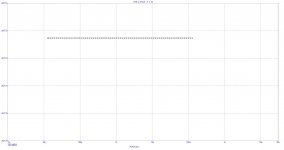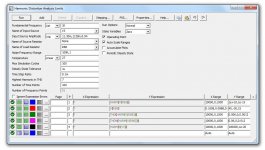Thread title borrowed from Nelson Pass.
https://www.diyaudio.com/community/...rtion-killer-circuit.24192/page-5#post-296714
I know that simulations are neither accurate, nor reliable, nor credible, nor are the results achievable in reality, nor [add here what you like]
My simulation results in Microcap12 before 1 month looked like this:
Conditions: Bias 1.5A. Load 8 ohms. Peak power. THD @1kHz
1k: -208dB should translate into 0,000000008 %
I started to become suspicious because THD was already flat until 30W or so...
In the past, when the circuit was not so refined, distortion was always constantly rising with power, starting at -180dB at 10mW power.

https://www.diyaudio.com/community/...rtion-killer-circuit.24192/page-5#post-296714
I know that simulations are neither accurate, nor reliable, nor credible, nor are the results achievable in reality, nor [add here what you like]
My simulation results in Microcap12 before 1 month looked like this:
Conditions: Bias 1.5A. Load 8 ohms. Peak power. THD @1kHz
1k: -208dB should translate into 0,000000008 %
I started to become suspicious because THD was already flat until 30W or so...
In the past, when the circuit was not so refined, distortion was always constantly rising with power, starting at -180dB at 10mW power.
Are there amplifiers (with available schematics) that perform extremely well in simulation ?
Any simulation results you can post ?
Is pspice better ?
Any simulation results you can post ?
Is pspice better ?
Simulations are always plagued with errors thanks for incomplete models. For example: does any simultion take into acount parasitics between PCB tracks?
I mentioned that in the 3rd line of the first post.
The problem is that I can not see possible further improvements because the program seems to have limitations.
The problem is that I can not see possible further improvements because the program seems to have limitations.
Hire programmers to write a brand new simulator that is free of all limitations, then sell it (software-as-a-service) in the form of annual licenses. If the market is huge, your profits will be huge too.
Sine source defined by 64bit numbers would give a dynamic range of 384dB ?
Or is the number of points for a full wave to small due to not optimal settings ?
Or is the number of points for a full wave to small due to not optimal settings ?
Or...don't simulate at all (the zero software license model) and just calculate, build circuits with real life parts on real PCBs and measure circuits with non virtual instruments. It is a question of getting accustomed to but then it works not only on a screen but also in real life with real life numbers!
Last edited:
Yes, but they are usually for RF use.Simulations are always plagued with errors thanks for incomplete models. For example: does any simultion take into acount parasitics between PCB tracks?
Blasphemy!! Next you will want us to listen with human ears, and that is not necessary. It is all in the math.build circuits with real life parts on real PCBs and measure circuits with non virtual instruments.
Those low distortion/noise numbers only live inside a computer.
Real world numbers are dominated by self noise and even linearity of passive components.
Check the performance of the best audio analyzers like the Audio Precision and they can not get more than -115dB or so for their top models.
As an example, you can calculate the self noise of an 1K resistor at 25 degrees Celsius and you will get something like -120dBV, if I recall it correctly.
By the way, I think simulation is a great and necessary tool and I am a PSpice user myself, but there are limits and common sense to be considered, too.
Real world numbers are dominated by self noise and even linearity of passive components.
Check the performance of the best audio analyzers like the Audio Precision and they can not get more than -115dB or so for their top models.
As an example, you can calculate the self noise of an 1K resistor at 25 degrees Celsius and you will get something like -120dBV, if I recall it correctly.
By the way, I think simulation is a great and necessary tool and I am a PSpice user myself, but there are limits and common sense to be considered, too.
Sure, simulation is not replacement for assembling a real prototype, it only helps to shorten the development time making is faster and cheaper.
At the end you need to assemble and measure a real prototype, or you will run into crazy conclusions as the numbers mentioned above.
At the end you need to assemble and measure a real prototype, or you will run into crazy conclusions as the numbers mentioned above.
Depends... Few have the ability to measure THD below about -110 dBc, so there is that. I also find simulations very helpful in separating the wheat from the chaff. If a circuit is fundamentally broken it will usually simulate like crap. If a circuit performs reliably well in the simulator there's a pretty good chance it'll also work in the lab. It's a lot easier, cheaper, and faster to change R from 100 Ω to 120 Ω in the simulator than it is to do so in the lab.
Tom
I seem to recall that the THD+N for the APx555 with the precision analyzer enabled is -125 dBc or thereabout. Mine reaches down there and hits -148 dBc on the THD alone.Check the performance of the best audio analyzers like the Audio Precision and they can not get more than -115dB or so for their top models.
Tom
I was thinking in the first post with less than -200dB numbers for distortion.
From the APx datasheet:
SYSTEM PERFORMANCE
Residual THD+N (22kHz BW)
-117 DB + 1.0 μV
Typical < -120 DB (1 KHZ, 2.0 V
From the APx datasheet:
SYSTEM PERFORMANCE
Residual THD+N (22kHz BW)
-117 DB + 1.0 μV
Typical < -120 DB (1 KHZ, 2.0 V
-120 decabel? Wow, that's -12000 dB!
Seriously, THD+N is something else than THD and the distortion floor of a simulator is dependent on accuracy and time step settings. Usually reltol is the most important accuracy setting. When the simulator has strobing, which most don't, you can force it to calculate precisely at time points that you later want to do a DFT. If not, you can just play with the maximum time step.
Seriously, THD+N is something else than THD and the distortion floor of a simulator is dependent on accuracy and time step settings. Usually reltol is the most important accuracy setting. When the simulator has strobing, which most don't, you can force it to calculate precisely at time points that you later want to do a DFT. If not, you can just play with the maximum time step.
Last edited:
- Home
- Amplifiers
- Solid State
- no mercy simulator killer circuit

